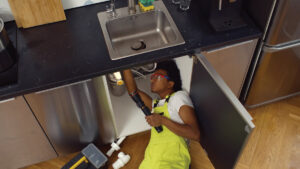Keeping your lights on has always been a high-tech job, but now it’s gone even higher. Take a look at new job titles electric co-ops are wanting to fill, like data scientist and cybersecurity analyst.
Lineworkers are adding to their skills as more homeowners install solar panels and sell the excess electricity back to the co-op—along power lines that used to only carry electricity in one direction.
“When lineworkers go out to fix a problem, they need to make sure they understand where the rooftop solar is so they can operate in a safe manner,” says Venkat Banunarayanan, vice president of integrated grid business and technology strategies with the National Rural Electric Cooperative Association (NRECA).
Banunarayanan describes a workforce evolution in electric co-ops resulting from two powerful trends—new patterns in the flow of electricity and the explosion of digital technology.
The radical idea of rooftop solar owners selling electricity back to the utility is just one of the new dynamics affecting the nation’s grid of electric poles and wires. The rapid rise in renewable energy complicates utility planning when solar power suddenly stops at sundown or calm weather cuts wind farm energy generation.
Electric co-ops are also preparing for the effects of more people charging up electric vehicles at home as every major car company has announced plans for electric cars and trucks.
If coordinating this new world of electricity sounds impossibly complicated, the almost-as-new world of information technology offers a solution.
It’s called the smart grid.
Over the past couple decades, power lines have been increasingly carrying not just power, but tons of data. The meter at your home is more sophisticated at recording and reporting your energy use. Attached to overhead power lines are tennis-shoe-sized boxes called sensors that monitor the performance of the wires and send that info back to your co-op.
Investments to develop the smart grid in the U.S. more than doubled the past six years, from $3.5 billion in 2014 to $7.8 billion in 2020, according to the analysis company Statista. That figure is expected to nearly double again by 2024 to $13.8 billion.
That money means new jobs. A report by the Energy Futures Initiative found that energy jobs grew at twice the rate of the overall economy from 2015 to 2019.
Parts of the smart grid rely on the internet, so that means growth in jobs related to cybersecurity. Specialists are needed to guard against internet hackers, not only to protect co-op member and business information, but to ensure the electric supply is safe and secure.
The new role of a data scientist determines how to use all that information coming in from the smart grid. Reports of electricity use coming into the co-op’s computers could reveal several members plugging in their electric vehicles to charge every day around 5 p.m. That puts extra demand on the utility when it’s already at peak use. A data scientist looking at those numbers could recommend a special rate to encourage those electric vehicle owners to start charging after 10 p.m. when overall energy use isn’t so high. Or they might recommend updating the utility’s transformers to handle the heavier use.
Those new careers—and yes you can go to school for a degree in data analytics—will also mean changes in other parts of the co-op. Managers of these new employees will be supervising more jobs that can be done remotely, and at any time of the day or night.
NRECA’s Banunarayanan says that adapting to a different workforce will mean a new era for co-op management as well, as they recruit and supervise not just a new generation of workers, but a new generation of work.
Photo: Emerging energy trends also mean new skillsets for lineworkers, particularly for servicing homes that include rooftop solar panels. Photo Source: Kelly Hester, Carroll EMC










